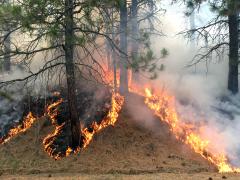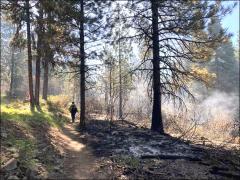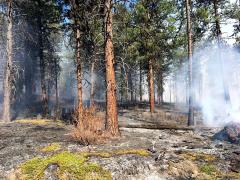By: Andrew Avitt, April 4, 2023-

Editor’s note: Prescribed fire is one of the many ways the Forest Service is confronting the wildfire crisis. This practice reduces wildfire risk and is essential to the agency’s 10-year strategy “Confronting the Wildfire Crisis: A Strategy for Protecting Communities and improving Resilience in America’s Forests.” The following article explores how the Forest Service plans and conducts prescribed burns that can benefit communities and critical infrastructure and create healthy, resilient forests.
In the Forest Service we often talk about using prescribed fire at the right place at the right time and at the right scale. It’s a simplified explanation. However, the process of calculating where, when and how to start a prescribed fire is much more complex than the pithy saying suggests.
“We don’t start with, ‘We’ve got these drip torches. We would like to use them.’ We start with, ‘What does the land need and why?’” said Frankie Romero, Forest Service fire use branch chief. “What are the benefits?”
Often the benefits are multiple: Mitigating wildfire risk to nearby communities and supporting ecosystems, wildlife, water quantity and quality.
Benefits to Local Communities
Prescribed fire helps reduce wildfire risk to communities and critical infrastructure. Fuels treatments, including prescribed burns, are meant to safely replicate the effects of naturally occurring wildfire, resulting in less available material to burn. Prescribed fires are less intense than wildfires.
Land that has been prescribed burned slows wildfire growth, thereby assisting firefighters as they fight to protect communities, property and infrastructure. Firefighters used these treated areas during the 2020 Cameron Peak Fire and the 2021 Caldor Fire, as well as many others, to operate safely and stop the wildfire’s spread, saving lives, homes and businesses.
Other benefits are not so obvious.
“Many communities depend on water from the surrounding wildland areas. Take for example a community located in a basin,” Romero said. “Precipitation all around the area and the hills is filtered through the soil, into the streams and into the watershed, and eventually to the community.”
When a wildfire severely burns an area, all tree and ground cover is removed, which reduces an area’s natural ability to hold and store water.
“If there’s no trees or organic material covering the ground, when rain occurs it flushes through the system fast. But with a healthy forest it takes longer for water to make its way through the watershed, which gives people more time to use it,” said Romero.
Erosion in areas devastated by extreme wildfire is another issue land managers are trying to mitigate with prescribed burns. Prescribed burns keep the forest canopy mostly intact presenting less risk of erosion and landslides. In contrast hotter wildfires remove most if not all canopy and ground cover.

Benefits to Ecosystem and Wildlife
Fire on the landscape is essential to supporting healthy ecosystems across the country. In the vast fire-adapted ecosystems of the West, Southwest, Great Plains and Southeast, prescribed fire can clear thick understory and overstocked forest stands. This allows nutrients to return to the soil and lessens competition for vital resources such as water and sunlight, allowing forests to reach their healthy potential.
“Where there are healthy forests there also tends to be thriving wildlife,” said Romero. “In some places, deer may prefer to eat younger brush and shrubs because of its palatability or nutrition. So, one common objective for a prescribed fire might be to clear older brush in order to increase the availability of younger vegetation that certain wildlife prefer.”
Cleared out understories are also ideal for some species of woodpeckers and quail. They like a more open forest stand and structure, which provides food and habitat.
“It depends on what your critter of interest is, but prescribed fires can be designed in particular ways to support many wildlife habitats,” said Romero.
The Prescription
Many ecosystems across the country are “fire-adapted,” meaning they are dependent on fire for growth, reproduction and resiliency.
“We cannot remove fire from these environments completely,” said Phil Graeve, a zone fire management specialist on the Payette National Forest. “We need to learn to manage fire through projects like prescribed burns, and to plan accordingly.”
After determining a prescribed fire will provide a benefit by either mitigating wildfire risk to communities, restoring forest health and/or further supporting wildlife habitat, trained personnel, like Graeve, begin planning.
It can take three to 12 months from the beginning of the planning stage to the start of the prescribed burn, requiring land managers to look at several variables. They collect data and compile a report listing a set of requisites, which is required for a prescribed burn. The report is often referred to as a burn plan, or prescription.
Doctors write prescriptions. They are trained professionals with education and experience who write prescriptions to treat certain health conditions. The same is true for prescribed fire. While Graeve may not be a medical doctor, he is a wildland fire expert. He understands that each landscape, just as each human, may need a certain prescription to be healthy. With 18 years of experience, he has responded to many wildfires and has implemented many prescribed burns across the country.
His experience and training have earned Graeve the title of burn boss, which means he is qualified to plan, organize and execute prescribed burns. Although he has an intimate understanding of fire behavior, he does not rely on his experience alone. Instead, he also factors in physical science, fire modeling and research when developing a burn plan.
“We use data from modeling, which tells us how a fire might behave when we burn a certain area under specific conditions,” said Graeve.
Some of these factors and conditions include:
- Fuel moisture: How much moisture is inside vegetation, which can affect how fast a fire spreads, how high flames reach and how intense they are.
- Forest stand characteristics: How dense a forest is or the amount of dead vegetation in the area due to insects, disease, invasive species, or drought.
- Historical data: When fires last occurred and how frequently.
- Terrain: How fire will behave on the landscape.
- Elevation: How an area’s elevation affects its fire regime, as well as the amount of fire needed to maintain a healthy ecosystem.

The Window
After a complete analysis, a burn plan is finalized, stating all the required conditions for when and where a prescribed burn will take place. If any one of the factors does not meet the requirements, the prescribed burn will be postponed until all conditions are met.
“Our policy states we must be within the prescription to conduct a prescribed burn,” said Graeve. “This means all environmental, weather conditions and projected fire behavior models must align with what is in the plan.”
The times when all conditions are met are referred to as burn windows. Burn windows vary across the country, but usually occur in spring, fall and winter due to wetter conditions. Burn windows can also close quickly because of weather conditions.
According to Graeve, wind speed and direction are among the most important factors considered on burn day because wind direction determines where the fire could spread and where smoke could go.
“Unlike wildfire, when we conduct a prescribed burn, we must adhere to air quality standards set by the Environmental Protection Agency, which means we must plan for smoke,” said Graeve. “If a community is on one side of a planned prescribed fire area and there is nothing on the other side, we will plan for a day with favorable wind direction.”
Conducting a prescribed burn is not without risk. The burn plan is designed to reduce the risk of a fire escaping and to mitigate smoke exposure to communities, Graeve explained. If a prescribed burn were to escape, contingencies are outlined in the burn plan. In general, that includes ordering additional pre-identified firefighting resources that are on standby, ready to respond to such an emergency.
“Prescribed fires only become wildfires about 0.13% of the time – about 1 out of 1,000 fires ignited,” he said, “And of that 0.13%, an even smaller percent ever goes on to damage property or structures.”
Learning and Improving
We can never guarantee that prescribed fires won’t escape because there are risks when we use this tool. We also cannot underestimate how destructive escaped prescribed fire can be. In the extremely rare instance when a prescribed fire does escape, firefighters are on standby to respond quickly. Once a prescribed fire is declared a wildfire, the agency undergoes a vigorous assessment to improve current systems for tracking findings and recommendations for continuous learning.
Last year, the Forest Service’s prescribed fire program underwent a national review. Based on the National Review Team’s findings, the agency adopted several actions to ensure prescribed fire plans are up to date with the most recent science, that key factors and conditions are closely evaluated the day of a prescribed burn, and that decisionmakers are engaged in those burns in real time to determine whether a prescribed burn should be implemented.
As a learning organization, we are undertaking steps to ensure prescribed fire practitioners have the tools and resources they need to be successful on the ground. These steps will help make communities safer and forests healthier as we implement our 10-year Wildfire Crisis Strategy alongside our many partners.
As we move forward, we will strive to hold ourselves accountable, learn from our successes and mistakes, and find better ways to serve the American people and steward the lands entrusted to our care, for the benefit of current and future generations.